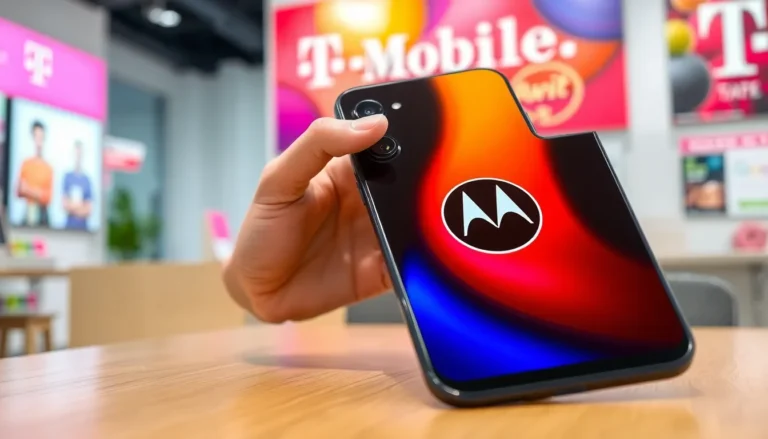In a world where smartphones have become an extension of ourselves, the way they look and feel can make or break our daily experience. Imagine trying to navigate your phone while it plays hide and seek with your favorite apps—frustrating, right? That’s where smartphone UX design swoops in like a superhero, transforming chaos into seamless interactions.
Table of Contents
ToggleOverview of Smartphone UX Design
Smartphone UX design focuses on creating a seamless user experience that prioritizes both aesthetics and functionality. Designers concentrate on intuitive navigation, ensuring users can easily access apps and features. Effective UX design minimizes frustrations associated with complex interfaces.
Research shows users spend an average of three hours daily on smartphones, making efficient design crucial. With ever-increasing device usage, delivering a user-friendly experience improves overall satisfaction. Key elements like touch responsiveness, visual hierarchy, and consistency shape user interactions.
Clarity in icons and buttons enhances user understanding, guiding them through different functions. Designers utilize feedback mechanisms, such as visual cues and animations, to inform users of their actions. This feedback builds confidence and encourages exploration within apps.
Accessibility features also play an essential role in smartphone UX design. Options like voice commands and customizable text sizes cater to diverse user needs, ensuring inclusivity. By adopting responsive design principles, apps adapt to various screen sizes and orientations, providing a consistent experience across devices.
Integrating user testing early in the development process leads to better design outcomes. This iterative approach gathers valuable insights, allowing designers to refine their products before launch. Prioritizing user needs results in devices that feel personalized and engaging, leading to higher retention rates.
Smartphone UX design merges aesthetics with functionality, fostering an environment where users can efficiently navigate their devices. Creating a delightful user experience remains a central objective, ultimately enhancing everyday interactions with technology.
Key Principles of Smartphone UX Design

Smartphone UX design revolves around enhancing user interactions while addressing their needs. Designers follow key principles that ensure an efficient and engaging experience.
User-Centered Design
User-centered design prioritizes the needs and preferences of users in the development process. Engaging with target audiences during research allows designers to gather valuable insights. Iterative testing reveals potential issues, enhancing usability. Feedback collected from users informs adjustments that align with their expectations. Focusing on intuition promotes effortless navigation throughout apps and features. Developers continually refine interfaces based on user input, guaranteeing a relatable experience.
Accessibility Considerations
Accessibility in smartphone UX design ensures all users can interact with technology effectively. Adapting interfaces to accommodate various abilities enhances inclusivity. Designers implement features like voice commands and screen readers, promoting ease of access. Text size customization and color contrast adjustments cater to diverse preferences. Accessible design principles prioritize usability for everyone, regardless of physical or cognitive abilities. Presenting clear icons and instructions aids understanding, making technology approachable.
Visual Hierarchy
Visual hierarchy organizes content in a way that captures attention and guides user interaction. Designers establish a clear structure using size, color, and placement of elements. Larger fonts and bolder colors draw focus to critical information, while subtle elements support the overall design. Prioritizing important features leads to seamless navigation throughout apps. Consistent alignment and spacing enhance readability and create a polished appearance. Effective visual hierarchy aids users in finding information quickly, optimizing their overall experience.
Common Challenges in Smartphone UX Design
Smartphone UX design presents several challenges that can impact user satisfaction. Designers must navigate these obstacles to create optimal experiences.
Screen Size Limitations
Screen size limitations create significant challenges. Smartphone screens typically range from 5 to 7 inches. This compact space restricts how much content can be displayed simultaneously. Designers must prioritize essential information while ensuring readability. It’s vital to balance aesthetics with functionality, as cluttered interfaces can lead to confusion. Users often have difficulty interacting with small touch targets, making precise navigation more critical than ever.
Touch Interactions
Touch interactions play a crucial role in smartphone UX design. Users rely on touchscreens for navigation, and responsive interactions enhance their experience. Designers face challenges in creating touch targets that are both accessible and visually appealing. Inadequate spacing between buttons can lead to accidental selections. Additionally, providing haptic feedback reinforces user actions, which improves satisfaction. Balancing gesture controls with traditional touch elements aids in intuitive navigation, ensuring users feel comfortable and confident in their interactions.
Performance Issues
Performance issues can severely hinder user experience. Slow load times and app crashes lead to frustration among users. Designers must optimize applications for speed and efficiency, especially given that users spend an average of three hours daily on their smartphones. It’s essential to conduct thorough testing to identify bottlenecks and improve responsiveness. Moreover, prioritizing battery consumption and memory usage ensures devices perform seamlessly. Addressing these performance challenges helps maintain user engagement and satisfaction, ultimately impacting the success of the application.
Best Practices for Smartphone UX Design
Focus on creating user-friendly interfaces that enhance functionality while maintaining attractiveness. Implementing best practices optimizes smartphone UX design.
Consistency Across Platforms
Consistency across platforms strengthens user familiarity. Design elements such as color schemes, fonts, and button styles should remain uniform on both mobile and web applications. Users anticipate similar navigational structures; maintaining this uniformity minimizes confusion. Adopting familiar design patterns fosters confidence, allowing users to engage more naturally with different devices. Ensuring a seamless experience translates into higher user satisfaction ratings, reinforcing brand loyalty.
Minimalist Design Approaches
Embracing minimalist design approaches minimizes distractions and focuses on essential features. Simple layouts with ample whitespace enhance clarity and usability. Prioritizing functionality over unnecessary decorations often leads to smoother navigation. Effective use of visuals aids comprehension while preventing information overload. Favoring primary colors and straightforward fonts helps users quickly locate what they need, creating a streamlined experience.
Feedback and Responsiveness
Implementing feedback mechanisms enhances user confidence during interactions. Visual cues such as button animations and notifications provide instant responses to user actions. Responsive designs cater to screen size variations, ensuring a consistent experience across devices. By optimizing load times and minimizing delays, users remain engaged without frustration. Testing and iterating based on user feedback can significantly improve overall satisfaction, validating design choices and fostering user trust.
Smartphone UX design plays a vital role in shaping user interactions and satisfaction. By prioritizing intuitive navigation and aesthetic appeal, designers can create experiences that resonate with users. The integration of accessibility features ensures that technology is inclusive for everyone.
Focusing on user-centered design principles allows for continuous improvement through testing and feedback. By addressing common challenges like performance issues and screen size limitations, designers can enhance usability and engagement.
Ultimately, a well-executed smartphone UX design not only meets user needs but also elevates everyday interactions with technology, making daily tasks more enjoyable and efficient.




